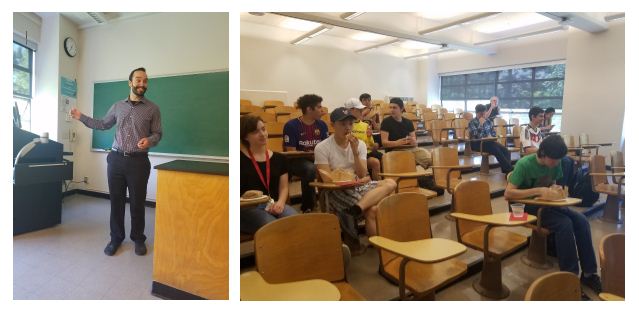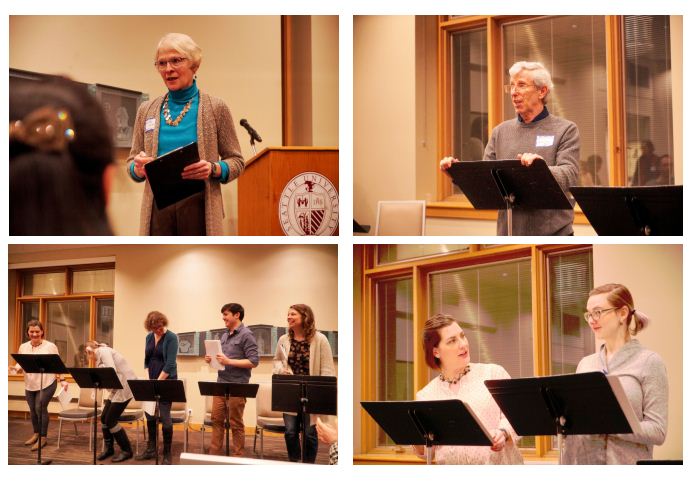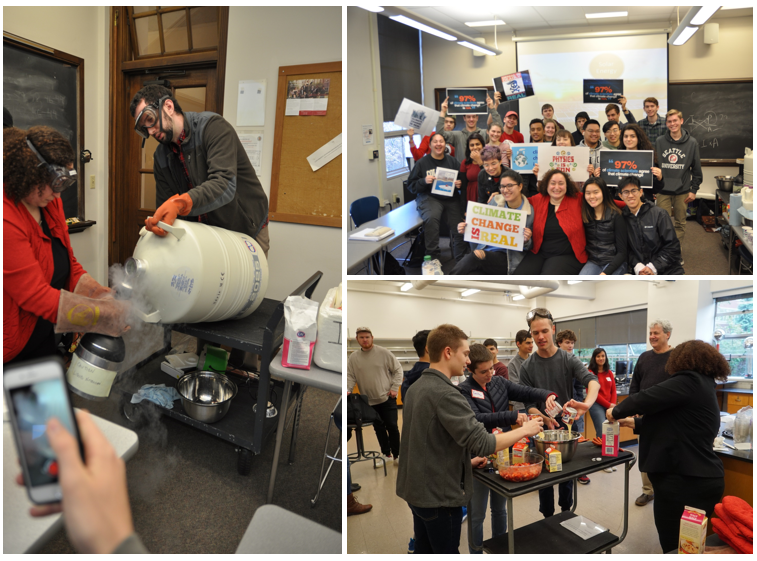
Archives
Physics News Archive
Congratulations to Bannan Scholar - Camile Zaug!
To be eligible for a Bannan scholarship, a student must be an undergraduate junior or senior with a full-time major in the College of Science and Engineering. The applicant must have a minimum GPA of 3.5 and have a demonstrated commitment to serving both the university and the greater community. The applicant must submit a biographical sketch, a personal statement describing volunteer service, and a faculty recommendation. Congratulations Camille on a great accomplishment!
Phyics Seminar with Ryan Hufschmid, PhDc
On May 23rd our Physics Seminar Series featured Ryan Hufshmid, a PhD candidate from the University of Washington, who discussed his work on "Using Electron Microscopy and Spectroscopy to Quantify Iron Oxide Nanoparticle Structure, Chemistry, and Colloidal Kinetics"
Physics Seminar Speaker - Paul Wiggins

We hope you enjoyed our Physics Seminar Speaker, Paul Wiggins. To read more of Paul’s interesting work in thermodynamics and inference, follow this link here: https://arxiv.org/abs/1706.01428
PhysFest 2019

Our tenth annual PhysFest was a great success! Thank you to all those who have made this event so successful over the last decade. PhysFest is a great opportunity for high school seniors to be introduced to the world of physics here at Seattle University. Students arrived on Friday where they enjoyed a reception and dinner with the physics department, followed by a brief orientation and tour of the physics facilities. Saturday was a packed day of experiments across a wide range of physics concepts. Thank you to all of those who were involved in making this year another great success!
5th Joint Meeting of the Nuclear Physicists of the American Physical Society
Mary Alberg and SU physics majors Ethan Hunt and Chase Kim attended the 5th Joint Meeting of the nuclear physicists of the American Physical Society and the Physical Society of Japan, in Waikoloa, HI, October 2018. Mary presented a talk on “The Pion Cloud and the Puzzle of the Proton Sea”. Ethan and Chase participated in the special sessions of the Conference Experience for Undergraduates and presented their posters: “Calculation of strangeness asymmetry in the proton sea” (Chase), and “Monte Carlo Calculations of the Light Flavor Asymmetry in the Proton Sea” (Ethan).
The 10th Annual Galileo Dialogues
In partnership with the Infinity Box Theatre Project, the Physics Department hosted the 10th annual Galileo Dialogues. The Galileo Dialogues is an annual rediscovery of Galileo's story and its influence on the relationship between science and culture, in the context of his time and ours.
Dr. Amal Al-Wahish Serves as Poster Judge and Panelist for CUWiP Conference

Dr. Al-Wahish served as a poster judge and panelist at the Conference for Undergraduate Women in Physics (CUWiP) on the topic of "Fields of Academic Physics." Read more about Dr. Al-Wahish, and her work by clicking this link here.
Conferences for Undergraduate Women in Physics (CUWiP)
Several students and Dr. Al-Wahish from the Physics Department attended the Conferences for Undergraduate Women in Physics (CUWiP) which was held at University of Washington.
Dr. Al Wahish was a poster judge and panelist for a session called “Fields of Academic Physics”. Camile Zaug presented a poster of her research, and Lucas Ehinger, who works with Dr. Amal Al-Wahish on Infrared Spectroscopy, went on a tour of the CENBA (Center for Experimental Nuclear Physics and Astrophysics) at UW. The students engaged with many scientists and physicists and learned many new things.
Ice Cream and Liquid Nitrogen Experiment
Students from Professor Amal Al-Wahish's UCOR classes had a great time making ice cream out of liquid nitrogen!
For the first time in 55 years, a woman shares the Nobel prize in physics!
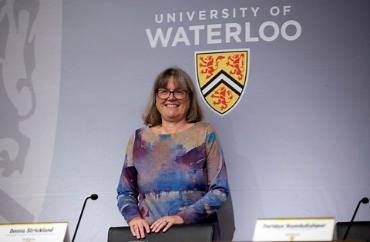
A trio of scientists won this year's Nobel prize, including Canada's Donna Strickland--the third female recipient in history and the first in 55 years. Amna Nawaz speaks with Strickland about her research in laser amplification, what she would tell young people interested in a physics career and how she plans to celebrate her landmark achievement.
Bannan Scholarship Recipients
Congratulations to our 2018-2019 Bannan Scholars! Physics students Neipori Pelle, Anna Rutledge, and Camille Zaug are among the recipients of the scholarship. Recipients of the Bannan scholarship have demonstrated academic excellence and a commitment to serving both the university and the greater community.
Physics Tribute to Stephen Hawking

March 14, 2018. In honor of Stephen Hawking and his great contributions to science, this drawing graces the chalkboard in the Physics hallway of the Bannan Building 3rd floor. Drawing inspiration goes to the Stephen Hawking Empty Wheelchair website.
PhysFest 2018
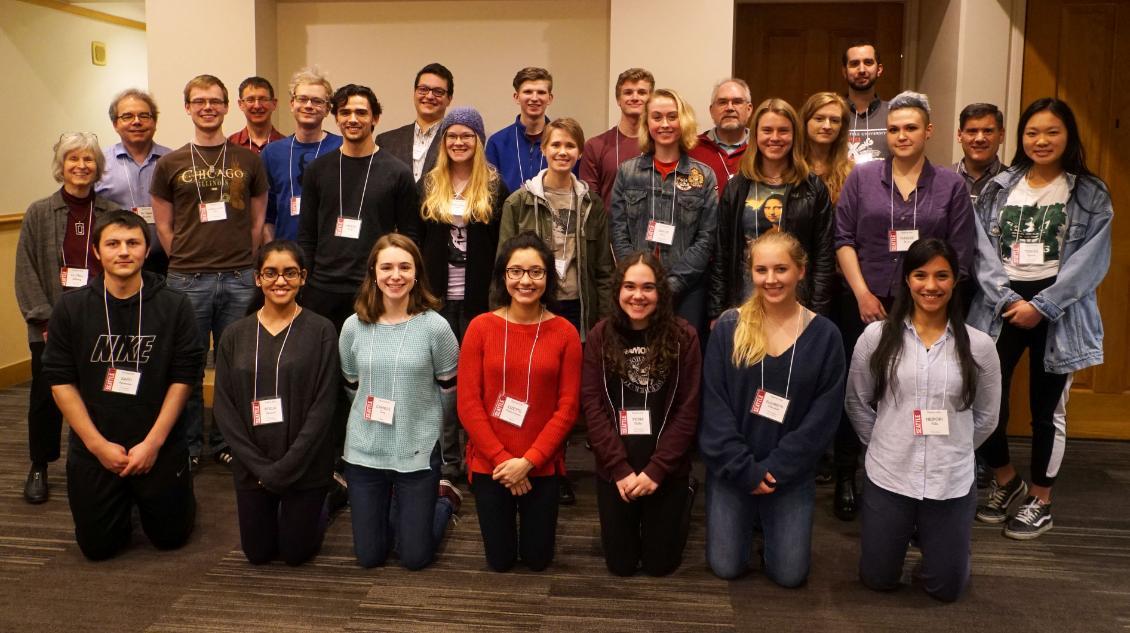
PhysFest 2018 was a great success! High school seniors from across the country were introduced to the world of physics here at Seattle University. Students arrived on Friday where they met their student hosts, enjoyed a reception and dinner with the physics department, followed by a brief orientation and tour of the physics facilities. Saturday was a packed day of experiments across a wide range of physics concepts. Thank you to all of those who were involved in making this year another great success!
Conference for Undergraduate Women in Physics
-370x277.jpeg)
Five of our current physics majors flew to Eugene for the APS Council for Undergraduate Women in Physics Conference. The goal of APS CUWiP is to encourage undergraduate women to continue in physics by experiencing a professional conference, gather information about graduate opportunities and future professions in physics, and network with other women in physics by sharing experience, advice, and ideas with peers and professionals.
Scholarly Summer
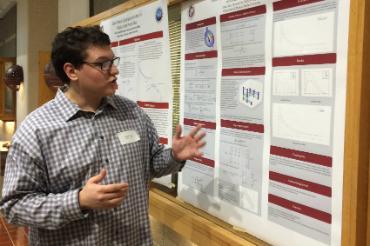
Ethan Hunt was featured in the SU Commons!
Physics Hosts Eclipse Viewing
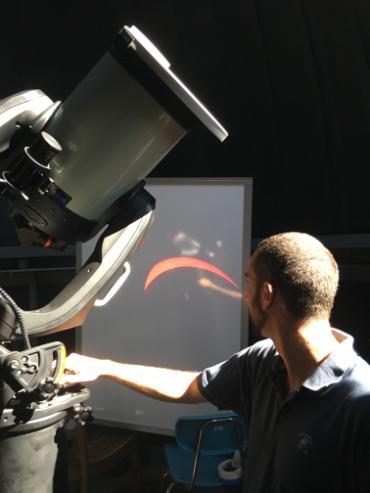

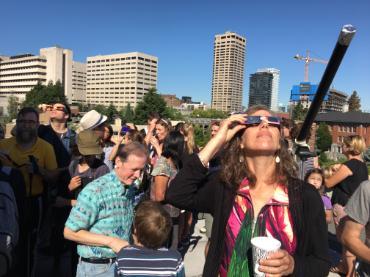

Prof. Joanne Hughes, Prof. Paul Fontana, and Lab Manager Chris Varney hosted a solar eclipse viewing 8-21-17 on the roof of Bannan. Using the telescope, they projected the progress of the eclipse, viewing glasses were passed amongst the crowd and some pinhole cameras rounded out the viewing options. Quite a crowd gathered and the feel was festive with everyone learning about and experiencing the wonder of the solar eclipse!
Dr. Hughes and 5 Physics Students Publish Pager in the Astronomical Journal

Dr. Joanne Hughes, Associate Professor in the Physics Department, published a paper in the Astronomical Journal in July, with a team which included 5 Seattle University past and present Physics Majors*. The paper, "A Multiwavelength Study of the Segue 3 Cluster" describes an imaging study of a 2 to 3 billion-year-old star cluster, using the Apache Point Observatory's 3.5-m Telescope (see Sloan Digital Sky Survey image of the cluster). The authors describe how they determined that this sparse group of stars is not native to our Galaxy, being too rich in iron and too young to belong to our outer halo, at a distance of about 95,000 light-years from Earth. The Milky Way's own halo globular clusters are all more than 3 times older than Segue 3, indicating that large spiral galaxies such as ours are still accreting dwarf galaxies and stripping them of stars, gas, and star clusters.
Physics Faculty Honored at Murdock Charitable Trust Scientific Research Awards
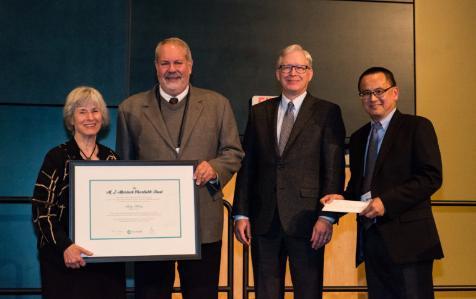
On November 5, 2016, Dr. Mary Alberg and Dr. Woo-Joong (Andy) Kim, were honored by the M.J. Murdock Charitable Trust for their research accomplishments.
Dr. Alberg is the inaugural recipient of the Lynnwood W. Swanson Scientific Research Award, honoring a senior natural sciences faculty member of a Pacific Northwest institution whose work has gained national recognition and who also has demonstrated leadership in engaging undergraduate students and promoting research at their institution. Dr. Alberg's work in theoretical nuclear physics of mesons and baryons, her mentorship of undergraduate student researchers, and her founding on the Anacapa Society caused her to stand out among the nominees.
Dr. Kim was the Honorable Mention for the Lynnwood W. Swanson Promise for Scientific Research Award, recognizing and honoring emerging junior faculty members.
Congratulations to Dr. Kim and Dr. Alberg!
Visit the Murdock Charitable Website HERE for more information about Dr. Alberg and Dr. Kim's honor.
Three Students Awarded Bannan Scholarships
Congratulations to Rose Marie Haynes, Christopher Riley, and Caleb Schmidt, who have been awarded Bannan Scholarships for the 2016-2017 academic year.
This scholarship program is named for its benefactor, Thomas J. Bannan, a leader in manufacturing, commerce, engineering and applied sciences and a man with a deep commitment to Seattle University.
To be eligible for a Bannan scholarship, a student must be an undergraduate junior or senior with a full-time major in the College of Science and Engineering. The applicant must have a minimum GPA of 3.5 and have a demonstrated commitment to serving both the university and the greater community.
Congratulations to our Bannan Scholars!
Grace Jesensky wins Outstanding Presentation Award
Grace Jesensky won an Outstanding Presentation award for her talk on research she did jointly with SU physics majors Dominic Dams and Oleksiy Khomenko, and SU Associate Professor of Physics Woo-Joong (Andy) Kim, at the American Physical Society March Meeting in Baltimore in March. The title of the talk was, “A simple table-top experiment demonstrating mechanical oscillation of a macroscopic object driven by radiation pressure.”
Congratulations, Grace!
Hanah Joudi '16 Featured on King5 News

Hanah Joudi, senior physics major, was featured on King5 News on October 28. Hannah spoke about her experience in the world of STEM and how millionaire investor Gary Rubens, in part with the Washington State Opportunity Scholarship, has helped make her education possible.
Summer Research 2015

Two Physics Students Awarded Bannan Scholarship
Congratulations to Dominic Dams and Caleb Schmidt who have been awarded the Bannan Scholarship for 2015-16.This scholarship program is named for its benefactor, Thomas J. Bannan, a leader in manufacturing, commerce, engineering and applied sciences and a man with a deep commitment to Seattle University.
To be eligible for a Bannan scholarship, a student must be an undergraduate junior or senior with a full-time major in the College of Science and Engineering. The applicant must have a minimum GPA of 3.5 and have a demonstrated commitment to serving both the university and the greater community.
Congratulations to our Bannan Scholars!
Prof. Alberg Featured in Reach

Undergraduate research is a vibrant part of the Physics faculty/student experience. Congrats to Dr. Alberg and her research students for being featured on the cover of the Science and Engineering magazine - REACH!
The quote on the right reads: "Even though I am deeply immersed in my research, the most important people in my professional life are my undergraduate students. It's thrilling to be in a community like this, which in some ways replicates my undergraduate experience. I had a mentor. I was one of those students who wanted to grow up to be like my professor, and I have, I think." Mary Alberg, PhD, Physics Professor
Dr. Kim's Research Makes AJP Cover
The American Journal of Physics Volume 83, No. 2, February 2015 issue features Dr. Andy Kim's research on the front cover. The research, conducted in partnership with SU students: M. Pahlmeyer, A. Hankins, and S. Tuppan is titled, Scanning capacitance microscopy using a relaxation oscillator. You can read the complete paper Kim research - scanning capacitance 1-22-15. Congratulations Dr. Kim, Marie, Andrew, and Sam!
Dr. Alberg elected APS Fellow
Professor of Physics Mary Alberg has been elected in November 2014 as a Fellow of the American Physical Society, the leading physicists' professional society in the world. The number of Fellows is small, with annual election limited to less than one-half of one percent of the membership. This is a great honor that most active physicists never achieve.
SU Physics Grads Excel
Nearly all of our recent graduates have been going on to graduate study or industrial employment.
Highlights:
Recent SU Physics grads are in, or have just completed, PhD degree work in physics at Georgetown U, the U of Oregon, the U of Michigan, and the Ohio State University.
Others are in PhD programs in engineering: Purdue U (Aerospace Engineering), Penn State U (Electrical Engineering), Vanderbilt U (Electrical Engineering), UC-Santa Barbara (Bioengineering), U of Maryland (Bioengineering), Northwestern U (Mechanical Engineering), the Ohio State University (Mechanical Engineering).
The earth and planetary sciences are also represented by our physics major graduates who entered PhD programs recently: U of Washington (Oceanography), U of Arizona (Planetary Sciences). Others have gone for the MS degree: UC-San Diego (Physics), Washington State U (Mechanical Engineering), Santa Clara U (Mechanical Engineering).
Three students recently entered the University of Oregon's Industrial Master's program.
Some of the jobs obtained by recent SU Physics grads not going on to graduate school are engineering or analyst positions at Boeing, at electro-optical companies, at the U of Washington School of Medicine, as well as computer programmer or network technician positions at various companies, including Microsoft.
Physics Department Awarded Grants
The Seattle University Physics Department has been awarded nine grants from federal agencies and from private foundations recently, and has been awarded more research grant support per faculty member than any other department at Seattle University.
Six of these grants are NSF research grants in physics or astronomy, awarded to SU Physics faculty Mary Alberg, Paul Fontana, Joanne Hughes Clark, and Andy Kim.
Each grant includes support for undergraduate student collaborators.
Further physics major undergraduate research support comes from our grants from the M. J. Murdock Charitable Trust and from NASA, as well as from grants from generous donors.
Calling all SU Physics Alumni
We want to hear from you! Drop us an email.
